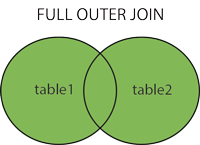SQL FULL OUTER JOIN
SQL FULL OUTER JOIN Keyword
The FULL OUTER JOIN keyword return all records when there is a match in
either left (table1) or right (table2) table records.
Note: FULL OUTER JOIN can potentially return very large
result-sets!
FULL OUTER JOIN Syntax
SELECT column_name(s)
FROM table1
FULL OUTER JOIN table2 ON table1.column_name = table2.column_name;
Demo Database
In this tutorial we will use the well-known Northwind sample database.
Below is a selection from the "Customers" table:
| CustomerID |
CustomerName |
ContactName |
Address |
City |
PostalCode |
Country |
1
|
Alfreds Futterkiste |
Maria Anders |
Obere Str. 57 |
Berlin |
12209 |
Germany |
| 2 |
Ana Trujillo Emparedados y helados |
Ana Trujillo |
Avda. de la Constitución 2222 |
México D.F. |
05021 |
Mexico |
| 3 |
Antonio Moreno Taquería |
Antonio Moreno |
Mataderos 2312 |
México D.F. |
05023 |
Mexico |
And a selection from the "Orders" table:
| OrderID |
CustomerID |
EmployeeID |
OrderDate |
ShipperID |
| 10308 |
2 |
7 |
1996-09-18 |
3 |
| 10309 |
37 |
3 |
1996-09-19 |
1 |
| 10310 |
77 |
8 |
1996-09-20 |
2 |
SQL FULL OUTER JOIN Example
The following SQL statement selects all customers, and all orders:
SELECT Customers.CustomerName, Orders.OrderID
FROM Customers
FULL OUTER JOIN Orders
ON Customers.CustomerID=Orders.CustomerID
ORDER BY Customers.CustomerName;
A selection from the result set may look like this:
| CustomerName |
OrderID |
| Alfreds Futterkiste |
|
| Ana Trujillo Emparedados y helados |
10308 |
| Antonio Moreno Taquería |
10365 |
| |
10382 |
| |
10351 |

Comments
Post a Comment